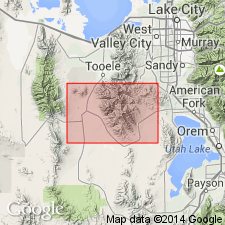
- Usage in publication:
-
- Deseret limestone*
- Modifications:
-
- Original reference
- Dominant lithology:
-
- Limestone
- Shale
- AAPG geologic province:
-
- Great Basin province
Summary:
Deseret limestone. Blue-gray, cherty limestone in beds averaging 2+/- feet thick, with a 6- to 8-foot bed of phosphatic shale at base; thickness 650 feet. At Ophir Creek section consists of (ascending): a bench-forming black shale with a phosphatic oolite bed at top, thickness 9 feet; and a steep slope-forming thin-bedded, massive to blocky, light- to dark-blue limestone (some of limestone beds are sandy, cherty, or fossiliferous), thickness 641 feet. Total thickness 650 feet. Conformably underlies Mississippian Humbug formation, the boundary being arbitrarily placed at base of first sandstone or quartzite bed of notable thickness. Rests conformably on Upper Mississippian Madison limestone; contact placed at base of a black (fresh), red (weathered) shale. If shale at base of Deseret can be correlated with shale at top of Gardner dolomite of Tintic district, then overlying limestone is probably equivalent to Pine Canyon limestone. Fossils (brachiopods) are upper Mississippian and correlate with lower part of Brazer limestone. Age is Late Mississippian.
Type locality not designated. Section measured on north side of Ophir Creek, in T. 5 S., R. 4 W. Also crops out in Mercur Canyon. Named from exposures at Deseret mine, Dry Canyon, in T. 5 S., R. 4 W., Stockton quadrangle [Mercur 7.5-min quadrangle], Tooele Co., north-central UT, Oquirrh Mountains region.
Source: US geologic names lexicon (USGS Bull. 896, p. 601); supplemental information from GNU records (USGS DDS-6; Denver GNULEX).
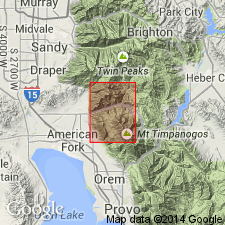
- Usage in publication:
-
- Deseret limestone*
- Modifications:
-
- Age modified
- Biostratigraphic dating
- AAPG geologic province:
-
- Great Basin province
Summary:
Age of Deseret limestone is revised from Late Mississippian --to-- Early and Late Mississippian, based on fossils [brachiopods, corals].
Source: GNU records (USGS DDS-6; Menlo GNULEX).
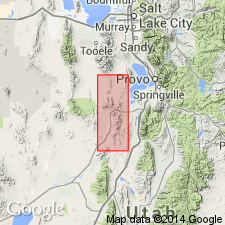
- Usage in publication:
-
- Deseret limestone*
- Modifications:
-
- Revised
- Overview
- AAPG geologic province:
-
- Wasatch uplift
- Great Basin province
Summary:
Deseret extended into area of this report and applied to a limestone unit that was named Pine Canyon limestone by Loughlin (1919) and for carbonaceous and phosphatic shale that was one of several units included in the Gardner dolomite. Both Pine Canyon and Gardner abandoned. Divided into the phosphatic shale member (base), Tetro member (adopted), and Uncle Joe member (new). A measured section in SE1/4 SE1/4 sec 19 and SW1/4 SW1/4 sec 20, T10S, R2W, Utah Co on the Wasatch uplift described where Deseret overlies Gardison limestone (new) and underlies Humbug formation. Detailed lithologic description. Extends into Juab Co, Great Basin province. Fossils (corals, bryozoans) identified from all three members. Is equivalent to Brazer limestone. Of Late Mississippian age. Geologic map. Correlation figures.
Source: GNU records (USGS DDS-6; Denver GNULEX).
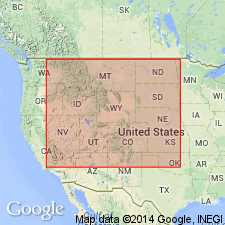
- Usage in publication:
-
- Deseret Limestone*
- Modifications:
-
- Revised
- AAPG geologic province:
-
- Great Basin province
Summary:
Topache Limestone abandoned. Rocks in Great Basin province of UT formerly assigned to Topache Limestone are reassigned to the Devonian and Mississippian Fitchville Formation, Mississippian Gardison and Deseret Limestones, and Humbug Formation.
Source: GNU records (USGS DDS-6; Denver GNULEX).
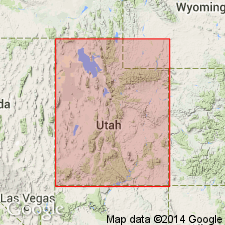
- Usage in publication:
-
- Deseret Limestone*
- Modifications:
-
- Revised
- AAPG geologic province:
-
- Wasatch uplift
- Uinta basin
Summary:
Divided into (ascending order): Delle Phosphatic Member (new) of Osagean age, Tetro Member of Osagean and Meramecian age, and the Uncle Joe Member of Meramecian age in Ophir Canyon, Oquirrh Mountains, Salt Lake Co, UT on Wasatch uplift. Extends into Uinta basin. Ophir Canyon lays in the foreland basin. Delle was called phosphatic member in earlier reports. Deseret overlies Gardison Limestone and underlies Humbug Formation. Basal contact is a hardground formed at top of Gardison. Delle also assigned as basal member of Woodman, Deep Creek, Little Flat, and Aspen Range Formations, and Chainman Shale and Brazer Dolomite at other localities. Correlation of Deseret with other units on the Wasatch uplift and in Great Basin province, UT, and in Snake River basin, ID, shown on correlation chart. Areal extent map of Deseret and of Delle.
Source: GNU records (USGS DDS-6; Denver GNULEX).
For more information, please contact Nancy Stamm, Geologic Names Committee Secretary.
Asterisk (*) indicates published by U.S. Geological Survey authors.
"No current usage" (†) implies that a name has been abandoned or has fallen into disuse. Former usage and, if known, replacement name given in parentheses ( ).
Slash (/) indicates name conflicts with nomenclatural guidelines (CSN, 1933; ACSN, 1961, 1970; NACSN, 1983, 2005, 2021). May be explained within brackets ([ ]).

